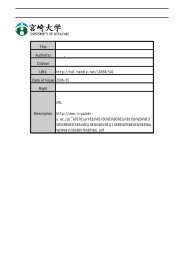Micrococcus luteus - 宮崎大学
Micrococcus luteus - 宮崎大学
Micrococcus luteus - 宮崎大学
You also want an ePaper? Increase the reach of your titles
YUMPU automatically turns print PDFs into web optimized ePapers that Google loves.
Summary<br />
In order to clarify the binding states of copper in microbial cells, copper biosorption from<br />
aqueous systems using the chemically treated <strong>Micrococcus</strong> <strong>luteus</strong> IAM 1056 cells (hot<br />
water-treated, diluted NaOH-treated, chloroform-methanol-treated, and chloroform-<br />
methanol/concentrated KOH-treated cells) was examined. The intact cells of <strong>Micrococcus</strong><br />
<strong>luteus</strong> adsorbed 527 μmol of copper per g cells, and its copper adsorption was very rapid<br />
and was affected by the solution pH. The chloroform-methanol/concentrated KOH-treated<br />
cells showed the higher copper biosorption capacity than the intact and the other<br />
chemically treated cells. The electron spin resonance (EPR) parameters, g// and |A//|, of<br />
Cu(II) ion in microbial cells indicate that Cu(II) ion in the intact and the all the chemically<br />
treated cells have coordination environments with nitrogen and oxygen as donor atoms,<br />
being similar to those of type II proteins. The parameter g// also indicated that the coupling<br />
between Cu(II) ion and the cell materials in the chloroform-methanol/ concentrated KOH<br />
treated cells is rather more stable than those between Cu(II) ion and cell materials in the<br />
other treated cells.<br />
2




